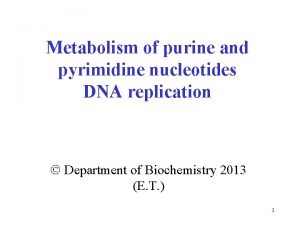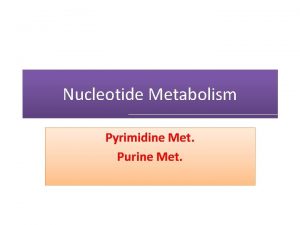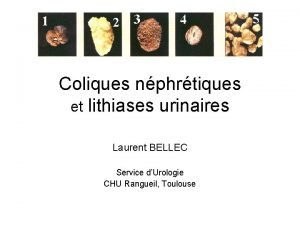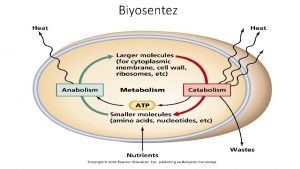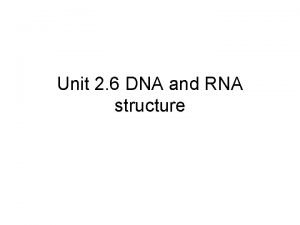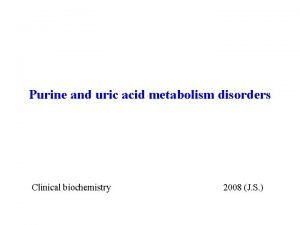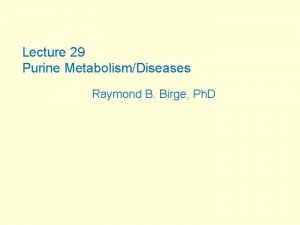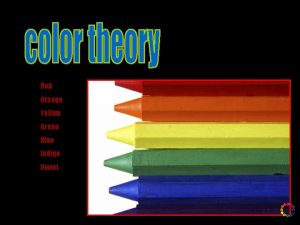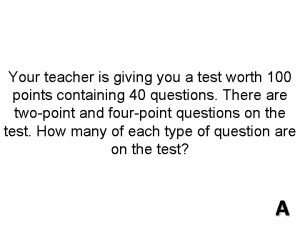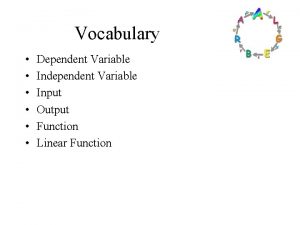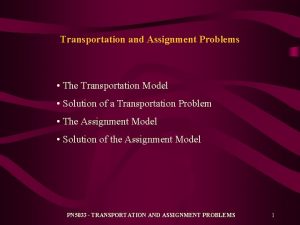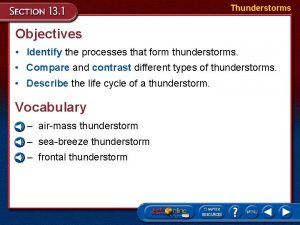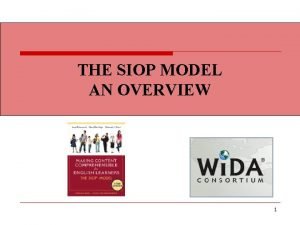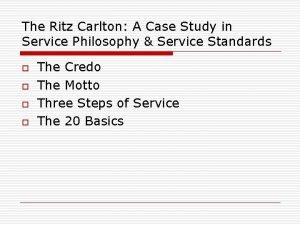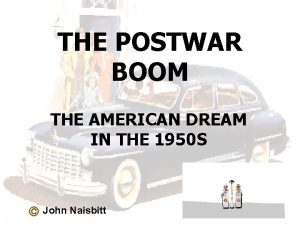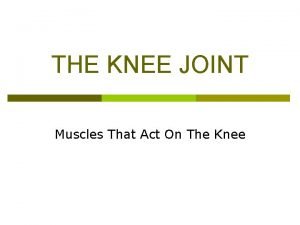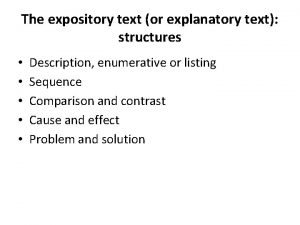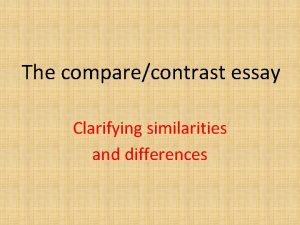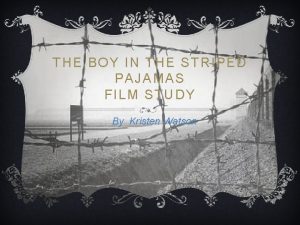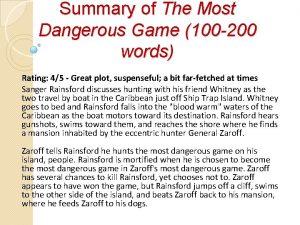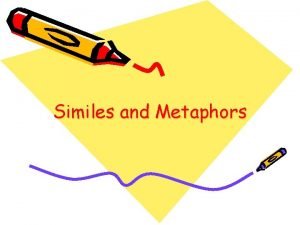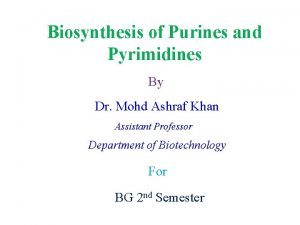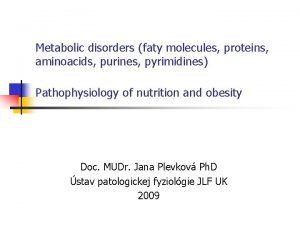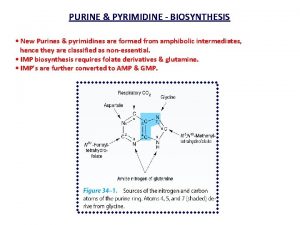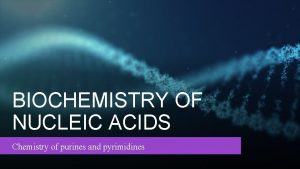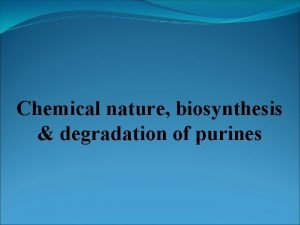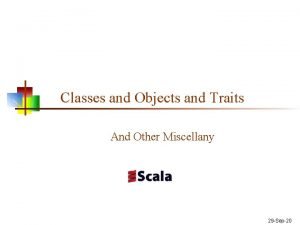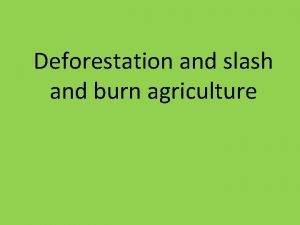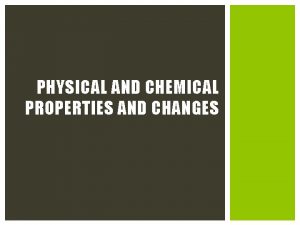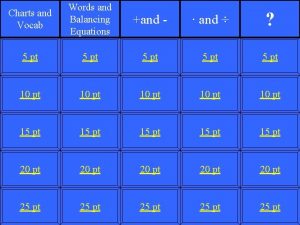27 23 Pyrimidines and Purines Pyrimidines and Purines
















































- Slides: 48

27. 23 Pyrimidines and Purines

Pyrimidines and Purines In order to understand the structure and properties of DNA and RNA, we need to look at their structural components. We begin with certain heterocyclic aromatic compounds called pyrimidines and purines.

Pyrimidines and Purines Pyrimidine and purine are the names of the parent compounds of two types of nitrogencontaining heterocyclic aromatic compounds. N N Pyrimidine N N H Purine

Important Pyrimidines that occur in DNA are cytosine and thymine. Cytosine and uracil are the pyrimidines in RNA. O O NH 2 CH 3 HN HN HN O N H Uracil O N H Thymine O N H Cytosine

Important Purines Adenine and guanine are the principal purines of both DNA and RNA. NH 2 O N N H Adenine N HN H 2 N N N H Guanine

Caffeine and Theobromine Caffeine (coffee) and theobromine (coffee and tea) are naturally occurring purines. O H 3 C O N N N O CH 3 N CH 3 Caffeine N HN O CH 3 N N CH 3 Theobromine

27. 24 Nucleosides

Nucleosides The classical structural definition is that a nucleoside is a pyrimidine or purine N-glycoside of D-ribofuranose or 2 -deoxy-D-ribofuranose. Informal use has extended this definition to apply to purine or pyrimidine N-glycosides of almost any carbohydrate. The purine or pyrimidine part of a nucleoside is referred to as a purine or pyrimidine base.

Uridine and Adenosine Uridine and adenosine are pyrimidine and purine nucleosides respectively of D-ribofuranose. O NH 2 HN N O HOCH 2 HO N N HOCH 2 O OH Uridine (a pyrimidine nucleoside) N N O HO OH Adenosine (a purine nucleoside)

27. 25 Nucleotides

Nucleotides are phosphoric acid esters of nucleosides.

Adenosine 5'-Monophosphate (AMP) Adenosine 5'-monophosphate (AMP) is also called 5'adenylic acid. NH 2 N N O HO P N N OCH 2 O HO HO OH

Adenosine 5'-Monophosphate (AMP) Adenosine 5'-monophosphate (AMP) is also called 5'adenylic acid. NH 2 N N O HO P HO N N OCH 2 5' 4' 3' HO O 1' 2' OH

Adenosine Diphosphate (ADP) NH 2 N N O HO P HO O O P N N OCH 2 O HO HO OH

Adenosine Triphosphate (ATP) NH 2 N N O HO P HO O O P N N OCH 2 O HO HO OH

ATP Stores Energy ATP ADP AMP Each step is endothermic. Energy for each step comes from carbohydrate metabolism (glycolysis). Reverse process is exothermic and is the source of biological energy. DG° for hydrolysis of ATP to ADP is – 35 k. J/mol

Adenosine 3'-5'-Cyclic Monophosphate (c. AMP) Cyclic AMP is an important regulator of many biological processes. NH 2 N N CH 2 O O HO O P O OH

27. 26 Nucleic Acids

Nucleic Acids Nucleic acids are polymeric nucleotides (polynucleotides). 5' Oxygen of one nucleotide is linked to the 3' oxygen of another.

Fig. 27. 22 A section of a polynucleotide chain.

27. 27 Structure and Replication of DNA: The Double Helix

Composition of DNA Erwin Chargaff (Columbia Univ. ) studied DNAs from various sources and analyzed the distribution of purines and pyrimidines in them. The distribution of the bases adenine (A), guanine (G), thymine (T), and cytosine (C) varied among species. But the total purines (A and G) and the total pyrimidines (T and C) were always equal. Moreover: %A = %T, and %G = %C

Composition of Human DNA For example: Purine Pyrimidine Adenine (A) 30. 3% Thymine (T) 30. 3% Guanine (G) 19. 5% Cytosine (C) 19. 9% Total purines: 49. 8% Total pyrimidines: 50. 1%

Base Pairing Watson and Crick proposed that A and T were equal because of complementary hydrogen bonding. 2 -deoxyribose A T 2 -deoxyribose

Base Pairing Likewise, the amounts of G and C were equal because of complementary hydrogen bonding. 2 -deoxyribose G C

The DNA Duplex Watson and Crick proposed a double-stranded structure for DNA in which a purine or pyrimidine base in one chain is hydrogen bonded to its complement in the other.

Fig. 27. 24 Two antiparallel strands of DNA are paired by hydrogen bonds between purine and pyrimidine bases.

Fig. 27. 25 Helical structure of DNA. The purine and pyrimidine bases are on the inside, sugars and phosphates on the outside.

Fig. 27. 26 DNA Replication C T As the double helix unwinds, each strand acts as a template upon which its complement is constructed. A G

Fig. 27. 26 DNA Replication A' C T G' C' A G T'

27. 28 DNA-Directed Protein Biosynthesis

DNA and Protein Biosynthesis According to Crick, the "central dogma" of molecular biology is: "DNA makes RNA makes protein. " Three kinds of RNA are involved. messenger RNA (m. RNA) transfer RNA (t. RNA) ribosomal RNA (r. RNA) There are two main stages. transcription translation

Transcription is the formation of a strand of m. RNA using one of the DNA strands as a template. The nucleotide sequence of the m. RNA is complementary to the nucleotide sequence of the DNA template. Transcription begins at the 5' end of DNA and is catalyzed by the enzyme RNA polymerase.

Transcription A G G T C A C T G T C C A G T G A C T A G C A T A G C T C As double-stranded DNA unwinds, a complementary strand of m. RNA forms at the 5' end. A T G T C A G G C A T T A C 5' G 3'

Transcription A G G T C A C T G T C C A G T G A C T A G C A T A G C T C Uracil is incorporated in RNA instead of thymine. A T A G T C G A G G C C A U T A C 5' G G 3'

Translation The nucleotide sequence of m. RNA codes for the different amino acids found in proteins. There are three nucleotides per codon. There are 64 possible combinations of A, U, G, and C. The genetic code is redundant. Some proteins are coded for by more than one codon.

Table 27. 4: m. RNA Codons Alanine Arginine Asparagine GCU GCC CGA CGC AGG GCA GCG UGU UGC Glutamine CAA Glycine Histidine GGU GGA CAU Isoleucine AUU CAG GGC Leucine Lysine UUA CUU AAA CCA CUA CCC CG CUC CUG Methionine AUG UUG AAG Serine UCU UCA GUA Threonine ACU ACA AAU AAC Cysteine GAU GAC Glutamic acid GAA AUA GAG CGU AGA CGG Aspartic Acid GGG CAC AUC Phenylalanine Proline UUU CCU UUC Tryptophan UGG Tyrosine UAU Valine GUU

Transfer t. RNA There are 20 different t. RNAs, one for each amino acid. Each t. RNA is single stranded with a CCA triplet at its 3' end. A particular amino acid is attached to the t. RNA by an ester linkage involving the carboxyl group of the amino acid and the 3' oxygen of the t. RNA.

Phenylalanine t. RNA

O OCCHCH 2 C 6 H 5 + NH 3 Phenylalanine t. RNA G G This AAA triplet is complementary to a UUU triplet of m. RNA; it is an anticodon. C UC GA A C C A C G C U U A A C G G A U U AU AC A C UGUG CU GA G C C C A GA G G U A AA CU G C

27. 29 DNA Sequencing

DNA Sequencing Restriction enzymes cleave the polynucleotide to smaller fragments. These smaller fragments (100 -200 base pairs) are sequenced. The two strands are separated.

DNA Sequencing Single stranded DNA divided in four portions. Each tube contains adenosine, thymidine, guanosine, and cytidine plus the triphosphates of their 2'-deoxy analogs. OH OH OH HO P O O POCH 2 O HO base O H

DNA Sequencing The first tube also contains the 2, '3'-dideoxy analog of adenosine triphosphate (dd. ATP); the second tube the 2, '3'-dideoxy analog of thymidine triphosphate (dd. TTP), the third contains dd. GTP, and the fourth dd. CTP. OH OH HO P O OH O POCH 2 O H base O H

DNA Sequencing Each tube also contains a "primer, " a short section of the complementary DNA strand, labeled with radioactive phosphorus (32 P). DNA synthesis takes place, producing a complementary strand of the DNA strand used as a template. DNA synthesis stops when a dideoxynucleotide is incorporated into the growing chain.

DNA Sequencing The contents of each tube are separated by electrophoresis and analyzed by autoradiography. There are four lanes on the electrophoresis gel. Each DNA fragment will be one nucleotide longer than the previous one.

Figure 27. 29 dd. A dd. T dd. G dd. C Sequence of fragment T TG TGA T G ACAT A T G ACAT ACG T

Figure 27. 29 dd. A dd. T dd. G dd. C Sequence of fragment Sequence of original DNA T A TG AC TGA ACT T G AC ACT G ACA ACT G T T G ACAT ACT G T A T G ACAT A ACT G T AT T G ACAT AC ACT G T AT G ACAT ACG ACT G T AT G C T G ACAT ACG T ACT G T AT G CA
 Biosynthesis of pyrimidine
Biosynthesis of pyrimidine Pyramidine synthesis
Pyramidine synthesis Tableau des aliments pauvres en purines
Tableau des aliments pauvres en purines Purines
Purines Purines names
Purines names Prdp biochemistry
Prdp biochemistry Purines
Purines Pink purple orange brown
Pink purple orange brown Willaim blake
Willaim blake Romeo and juliet and west side story comparison chart
Romeo and juliet and west side story comparison chart Shorter taller older tall
Shorter taller older tall 75 centavos in symbol
75 centavos in symbol Red, orange, yellow, green, blue, indigo and violet.
Red, orange, yellow, green, blue, indigo and violet. Your teacher is giving you a test worth 100 points
Your teacher is giving you a test worth 100 points Young and dyslexic structure analysis
Young and dyslexic structure analysis Compare and contrast maynard jackson and andrew young
Compare and contrast maynard jackson and andrew young West yorkshire health and care partnership
West yorkshire health and care partnership Draw and label a longitudinal wave
Draw and label a longitudinal wave Smkvqmuzwv4 -site:youtube.com
Smkvqmuzwv4 -site:youtube.com Independent on y axis
Independent on y axis Transitive and intransitive and linking verbs
Transitive and intransitive and linking verbs What is a life role definition
What is a life role definition Maintenance of records and reports
Maintenance of records and reports Prohibited route in transportation problem means
Prohibited route in transportation problem means Compare and contrast cold wave and wind chill factor
Compare and contrast cold wave and wind chill factor Profit and loss acount
Profit and loss acount Lesson preparation siop
Lesson preparation siop Allusion in macbeth
Allusion in macbeth Ritz carlton credo
Ritz carlton credo How were conglomerates and franchises alike and different
How were conglomerates and franchises alike and different Vastus lateralis origin and insertion and action
Vastus lateralis origin and insertion and action How does nick describe the guests at gatsby's party
How does nick describe the guests at gatsby's party The giver chapter 3 and 4 questions and answers
The giver chapter 3 and 4 questions and answers Explanatory text structure
Explanatory text structure Definition of compare/contrast
Definition of compare/contrast Compare and contrast analog and digital forecasts
Compare and contrast analog and digital forecasts Childhood is measured by sounds and smells and sights
Childhood is measured by sounds and smells and sights The blind man and the elephant question answers
The blind man and the elephant question answers Hub and spoke disadvantages
Hub and spoke disadvantages Venn diagram of typhoon and tornado
Venn diagram of typhoon and tornado Input and output reports and analysis
Input and output reports and analysis Summary of the most dangerous game
Summary of the most dangerous game Whats a complete predicate
Whats a complete predicate Compound inequality and
Compound inequality and Soldering brazing and welding
Soldering brazing and welding Poem using similes and metaphors
Poem using similes and metaphors How do offspring inherit traits
How do offspring inherit traits Separation of powers and checks and balances
Separation of powers and checks and balances Sdlc principles and practices
Sdlc principles and practices
